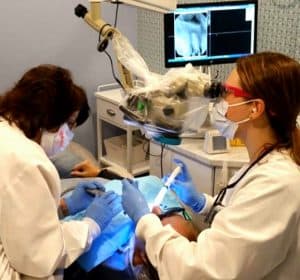What Happens During a Root Canal?
A local anesthetic will be given (“novocaine” for example). Then, a sheet of latex called the “rubber dam” (for allergic patients, we have non-latex ones too) will be placed around the tooth to isolate it, hence keeping it clean and dry during treatment. After isolating your tooth so that she can work in a clean enviroment, Dr. McIntyre will make a hole into your tooth on the biting surface (or behind the tooth for the front teeth) giving her access to the nerve. She will remove and clean the nerve and disinfect the “canal” system that your tooth has with instruments and disinfecting solutions. After instrumentation and rinsing with the disinfecting solutions, she will either complete the root canal with a root filling material, or she will medicate the tooth with an anti-bacterial medicament to neutralize the inflammation and infection.

The number of visits will depend on your particular case. Some treatments take 2 visits but many are just a single visit, and rarely, 3 appointments are needed. Thorough root canal therapy depends on the degree of infection/inflammation and degree of treatment difficulty. Here, it’s more important for us to do the very best we can, and Dr. McIntyre’s goal is to return you to your dentist symptom-free, with a very cleaned out and disinfected tooth that has been filled in all its nooks and crannies.
Similar to medicine and the human body, however, there are, of course, no guarantees in dentistry either. Root canal or endodontic therapy has a very high degree of success, approximately 95%! We will discuss with you the chances of success before any endodontic procedure to help you make an informed decision. If a root canal or endodontic therapy is unsuccessful or fails you still have options, which we will be happy to discuss with you.
